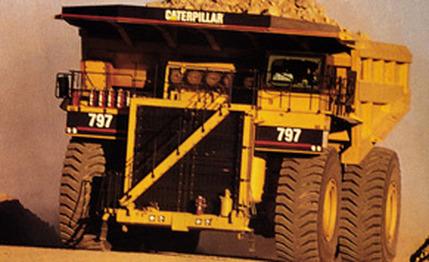 Specialty File
Specialty File
The Caterpillar 797 is the largest truck ever. But unless you work in a mine, you're probably never going to see one. That's a shame, because this is the real thing: a vehicle that's authentically awesome. Not awesome in a jokey monster truck sort of way, and not a goof like a pickup built on a Kenworth chassis, but a big, serious machine built for an epic, real-world task. Mining may well be the opposite of show business, but this truck has star power to spare.
As we approach the two prototype 797s in the yard of Caterpillar's Arizona training facility, their scale seems otherworldly. They stand 23 feet 9 inches tall when the dump bodies are down, and 49 feet 3 inches when they're tilted up, which means they dwarf the 240-ton 793C that used to be Cat's biggest truck. Nose the front end of one up to an NBA backboard, and the rear will stick out eight inches past half-court (that's 47 feet 8 inches). At 30 feet wide, park the left side even with that basket and the right side will be eight feet past the three-point line. But most gym floors aren't reinforced to withstand their 560,000-pound weight when empty, much less the 1,280,000-pound total when burdened with 360 tons of rocks and dirt. And with 12,170 pound-feet of torque available from the 117-liter, V-24, quad-turbo diesel, either 797 could rip Madison Square Garden off its foundation and tow it across Manhattan and into the East River.
The 797 is this big because the machines built to tear open the Earth have grown ever larger. When the world's biggest shovels were grabbing the planet in 60-ton scoops, the trucks built to haul stuff away were rated at four shovelsful. Now shovels are in the 90-to-100-ton range, and efficient mine owners need trucks that swallow 360 to 400 tons. So the 797 carries a nominal load rating of 360 tons, but it's capable of accepting 400 tons. And 400 tons is roughly the weight of 120 Ford Excursions. When shovels grow again, so will the trucks.
Beyond the 797's cost of $3.4 million, mine operators need to make serious infrastructure changes to accommodate it. The mining roads they operate on, for instance, must be three times the width of the widest truck running on them, and the service shops often need enlarging and reequipping. After all, mines aren't usually anywhere near civilization, so when Cat delivers a new 797, it arrives in pieces aboard 12 semis, which is to say, "some assembly required." Throw in driver retraining and a fuel depot that can fill the 797's 850- or optional 1800-gallon tank, and the commitment is obvious.
The 797's basic structure is nine massive castings that make up its welded chassis. Bolted to that are a four-link, live-axle rear suspension on suitably enormous hydraulic pistons and a front suspension that is essentially two hydraulic Parthenon-pillar-sized cylinders. The real load carrying, however, lies with the six Michelin radial tires. Specifically engineered for the 797, their 55/80R-63 size (that's 55 as in 55-inch section width and 63 as in the diameter of the wheel is 63 inches) is actually low profile for such a heavy-duty application, and although each tire stands 12 feet 10 inches tall and weighs more than 10,000 pounds, they have the same shape and broad shoulders of the tires on, say, a Chevy Tahoe or Suburban.
Although many competitors use hybrid diesel-electric drivetrains (as the Dresser Haulpak 830E we tested in July 1992 did), Cat mining trucks are direct driven, using Cat-built drivetrains. The 797's powerplant is essentially two V-12s lashed together with integrated intake, exhaust, and turbocharger systems. Each of the 24 4.9-liter cylinders breathes via four valves and is pressurized by four Garrett 60-series turbos. From there, the resulting 3400 horsepower travels back through an immense torque converter to a seven-speed automatic transmission and then on to the 1.27:1 gears in the rear end's differential. The final-drive ratio is further reduced by 16.70:1 reduction gears in the hubs. Flat out, the 797 will do 40 mph.